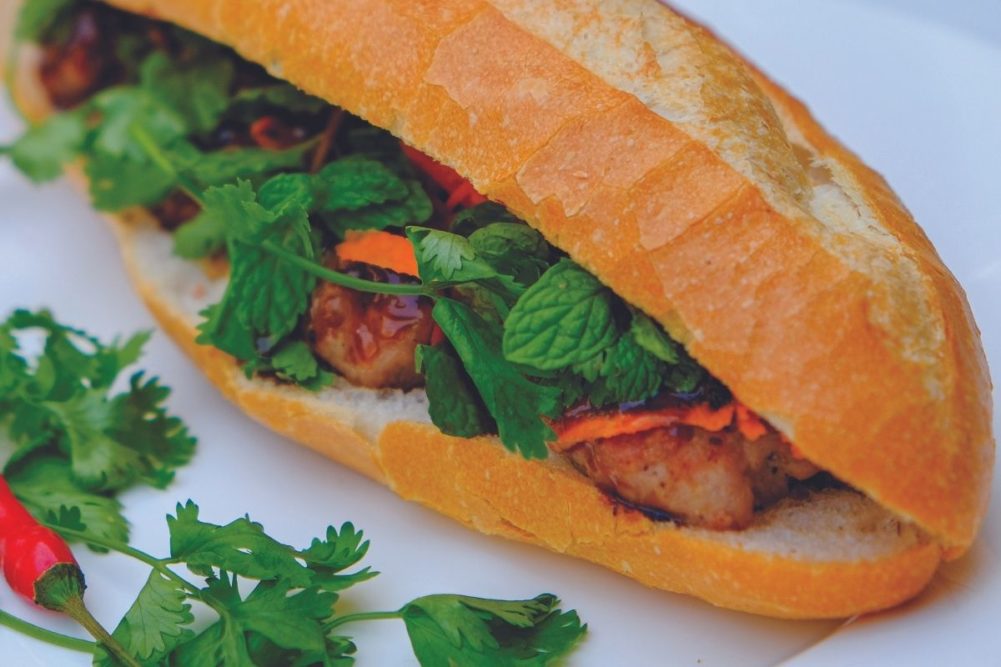HANOI, VIETNAM — Vietnam has a growing appetite for bakery products. According to Statista, the average per capita consumption is already 31.4 kg, and the growth rate is expected to increase by 4.86% annually through 2026. To a large extent, this boom is due to the popular street food bánh mì, an airy wheat roll lavishly filled with meat, vegetables and sauces. Other baked foods like sandwich, toast or flat bread play only a negligible role in the Vietnamese cuisine.
Bánh mì is a culinary legacy of the French colonial era. At first glance, the product resembles a small baguette. But whereas baguettes have a coarse-pored crumb and a thick, rustic crust, a perfect bánh mì must have a thin, delicately flaky surface, a fine-textured crumb and a much larger volume.
Classic away-from-home meal
Bánh mì is a classic away-from-home meal. In every city, countless snack stalls, mobile cookshops, fast-food chains and restaurants stand ready to serve their customers with a substantial bánh mì. For many Vietnamese, it has become a cherished daily ritual to buy such a filled roll from a takeaway and eat it out of their hand – on the way to work in the morning, during lunch break or after work.
Traditionally, bánh mìs are filled lavishly with pork pâté, grilled belly of pork and Vietnamese sausage. These are accompanied by cucumbers, pickled vegetables, herbs, lettuce, tomatoes, meatballs, cheese or omelette, just as the customer wishes. The flavor is rounded off with hot chili dips, spicy barbecue sauces or creamy mayonnaise. It is this unique mixture of sweet and sour, spicy and mild, and hot and cold that magically transforms an ordinary filled roll into a Vietnamese specialty full of contrasts.
Artisan bakers dominate market
Although the filling of a bánh mì can vary greatly according to the region and personal tastes, where the roll is concerned, all Vietnamese have the same preference — they expect a very high volume, a delicately flaking, translucent crust and a silky-soft crumb.
Freshness is another important quality criterion, so the street stalls fetch their bakery products fresh from an artisan bakery every day. Alongside small family businesses, medium-sized bakeries also have established themselves in Vietnam. But industrial bakeries play only a minor role.
As a rule, all-purpose flour with a medium protein content is used. The imported wheat comes mainly from Australia and the United States.
Vitamin C tablets strengthen gluten
For many years, Vietnamese bakers have sworn by a special procedure in the production of yeast-leavened wheat doughs. A dissolved vitamin C tablet is added to the water used in the process.
Most Vietnamese bakers adhere firmly to this tradition even though the flour is usually fortified with ascorbic acid and other highly functional flour improvers at the mills.
The typical preparation method and recipe is shown at the right.
To prepare, mix all ingredients at high speed to form a soft, slightly tacky dough. Divide the dough immediately and round it loosely. Leave to rest only for a very short time before shaping. Shaping involves elongating the dough by slapping it against the table, folding it in half and finally rolling it to form a tight log. Proof for about three hours in wooden trays at the ambient temperature. When the volume has increased significantly, make vertical or diagonal incisions across the proofed dough. Spray the loaves with water or diluted syrup before baking.
In the past, wood-fired ovens were common, but nowadays electric ovens are generally used. The oven must be adjusted expertly to ensure even heating and optimal browning and bloom of the bánh mì. The process takes five hours and is finished properly when the bánh mì makes a crackling sound on removal from the oven, caused by the cool air meeting the hot bread and making the crust crack.
High humidity causes problems
In the sub-tropical regions of northern and central Vietnam, especially, it is a great challenge to maintain this oven-fresh crispness for several hours. The thick crust typical of French baguettes would absorb too much moisture and result in a tough, leathery chewing feeling. For that reason, a thin, translucent surface is preferable for the Vietnamese version. A deep incision also helps to ensure that the dough piece has a larger surface, and the crust therefore stays crisp for a longer time.
Typical features of a premium bánh mì are a soft, airy interior and a paper-thin, light brown crust that flakes slightly when pressed. Furthermore, a fine, homogeneous texture is desirable so that sauces and dressings can be spread evenly and do not make the crumb soggy. In order to produce rolls with these characteristics, flour quality, technical equipment and process parameters must be adjusted to each other closely in the baking process. The following is an overview of the most common errors that occur in practice and what can be done to avoid them:
Problem: Poor stability, dough collapses when transferred to baking tray.
Solution: Reduce the water content, reduce fermentation time and increase ascorbic acid (ELCO P-100 K), add lipase (Alphamalt LP 20056 F) and/or add glucose oxidase (Alphamalt Gloxy 21084).
Problem: Not enough oven spring or shred/“wing.”
Solution: Increase mixing time; use lower-protein flour; increase ascorbic acid (ELCO P-100 K); add glucose oxidase (Alphamalt Gloxy 21084).
Problem: Low volume.
Solution: Optimize kneading time and prolong fermentation time. If the dough is weak, increase glucose oxidase (Alphamalt Gloxy 21084 / Alphamalt SI Gloxy 31001) and lipase (Alphamalt LP 20056F). If the dough is tough and lacks extensibility, increase amylase (Alphamalt VC 5000) and hemicellulase (Alphamalt HC 14090).
Problem: Unsatisfactory crispness and browning.
Solution: Prolong baking time; increase the baking temperature and add gluco-amylase (Alphamalt GA 5071 / Alphamalt GA 23750).






